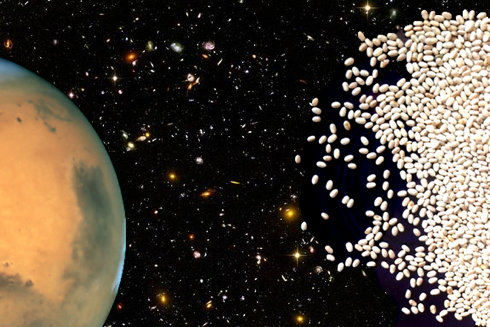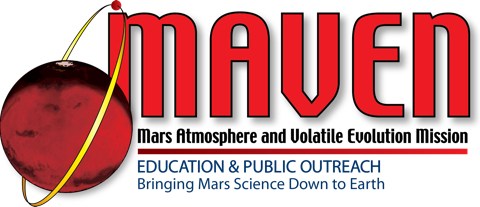Grade Level
3 - 5
minutes
Multi-day
subject
Earth Science
Activity Type:
astrobiology, experimental design, extreme environments
This activity was created by MAVEN Education and Public Outreach as part of the “Red Planet: Read, Write, Explore!” lesson series. Learn more about NASA’s MAVEN mission to Mars and find other free, exciting lessons and activities on their website.

Astrobiology is the study of life and the possibility that life could exist elsewhere in the universe. For example, Mars interests astrobiologists because it likely had water flowing on it at some point in its history, and most scientists believe that water is a necessary ingredient for life to exist.
The conditions on other planets may not always be suitable for life, however. Other planets may be extremely cold, hot, dry, or toxic to life as we know it. By studying life in extreme environments on Earth, we can find out whether organisms can live in environments like the ones we find on other planets.
Earth provides plenty of examples of organisms surviving extreme conditions. For example, scientists have found microorganisms living in acidic conditions, boiling water, and harsh cold. There are even microscopic creatures on our planet that thrive on radiation!
Watch the Science Friday video “Behold the Mighty Water Bear” below to learn about one example of an organism that can survive extreme environments similar to the conditions we might find on other planets.
SciFri Video: “Behold the Mighty Water Bear”
In this activity, students will devise an experiment to find out whether chia seeds are still able to grow after exposure to extreme conditions like the ones we might find on other planets. Click here to download the full teacher guide, complete with background reading, standards alignment, and lesson plan.
Materials
One small package of chia seeds (eight grams)
One roll of absorbent paper towels
One box zip-to-seal sandwich bags
One permanent marker
One small plastic bowl per student, labeled with his or her name
One tray per student
One pitcher for water
Safety glasses, one pair for each student
Lab aprons, one per student
Optional weak acids: 3% hydrogen peroxide, white vinegar, seltzer
Optional weak bases: Epsom salt (MgSO4) or table salt (NaCl)
Optional equipment: access to an oven, microwave, or freezer
Safety Considerations
Make sure all investigators wear eye and spill protection and review and follow warning indications for any weak bases or acids chosen for this experiment. Never eat or drink anything in the laboratory, and take care to use hot pads when working with any containers heated in the oven or microwave. Please review our policies page.
Procedure
Students will devise an experiment to identify whether or not extreme conditions impact seed growth. Before beginning, discuss reasonable experiments students could conduct, such as:
- Putting seeds into the microwave to expose them to radiation (Note: seeds can survive for at least three minutes in the microwave. Students could choose different microwave times and record the amount of time. Do not put the seeds in water before microwaving.)
- Freezing seeds overnight
- Freezing seeds in water and letting them thaw
- Trying to grow seeds in the dark
- Soaking seeds in a weak acid, like soda water, citric acid, or hydrogen peroxide
- Exposing seeds to basic solutions, such as Epsom salt or water containing table salt
- Putting seeds in the sunlight for a day or more
- Another reasonable experiment of their choosing
- Have each student describe his or her experiment and make some observations and predictions on Part 1 of the student worksheet.
- Students should each receive about a dash of seeds each for experimentation. Reserve a dash of seeds in a bowl labeled “control” that the whole group can refer to for comparison after the experiment.
- Review lab safety and materials that are available to use with students, helping them with their experiments when needed.
- Help students to conduct their experiments. When they’re done, pass out the labeled bowls.
- Instruct students to place their seeds into their bowls.
- Fill the pitcher with lukewarm water, then fill each bowl (including the “control” bowl) so that the seeds are covered.
- Allow seeds to soak for about 24 hours.
- After that time period, give each student a paper towel, a sandwich bag, and a tray.
- Have students fold the towels in fourths and then open them flat on the tray.
- Have students pour the contents of their bowls onto one of the quarter sections, fold the towel up, and place it into the plastic bag.
- Come around and pour a little extra water onto any paper towels that aren’t saturated.
- Partially zip each bag so that about a half-inch is left open.
- Have students place their bag in their bowl on the tray. Double-check to make sure that each bag has a small amount of extra water in the bottom so the towel does not dry out.
- Place the try in a sunny window, and check the seeds daily. For the control seeds, small sprouts should form within 48-72 hours.
- Have students record and summarize their observations using Parts 2 and 3 of the student worksheet.
Example Discussion Questions (allow for open discussion)
- Which experimental results surprised you the most?
- What do your observations tell you about the chia seeds? Do you think this applies to all life?
About MAVEN Education and Public Outreach
MAVEN Education and Public Outreach consists of educators from the University of Colorado Boulder’s Laboratory for Atmospheric and Space Physics (LASP), University of California Berkeley’s Space Sciences Laboratory (SSL), NASA Goddard Spaceflight Center/ Lunar and Planetary Institute (LPI), Indigenous Education Institute (IEI), the SETI Institute, and the Latin American Center for Arts, Science, and Education (CLACE). Our goal is to create exemplary formal and informal education materials for NASA’s MAVEN mission to Mars.
About the Red Planet: Read, Write, Explore! Lessons
Red Planet, available in both English and Spanish, is a set of six lessons and activities for upper elementary grades that combines science, literacy, and art. The lessons address issues of Mars, Martian history, planetary habitability, and human space travel. They are a part of a broader effort to engage students and the public with the MAVEN mission, a mission to Mars that will study Mars’ upper atmosphere. It’s thought that Mars once had a wetter, watery past and a thicker atmosphere. At some point in its history, around four billion years ago, Mars started losing atmosphere, eventually leaving it the desert-like environment we see today. MAVEN will help us understand how much atmosphere Mars is losing today in order for us to work backward to figure out how much atmosphere it lost over time.
Meet the Writer
About MAVEN Education and Public Outreach
The Goal of MAVEN Education and Public Outreach is to create exemplary formal and informal education materials for NASA’s MAVEN mission to Mars.

